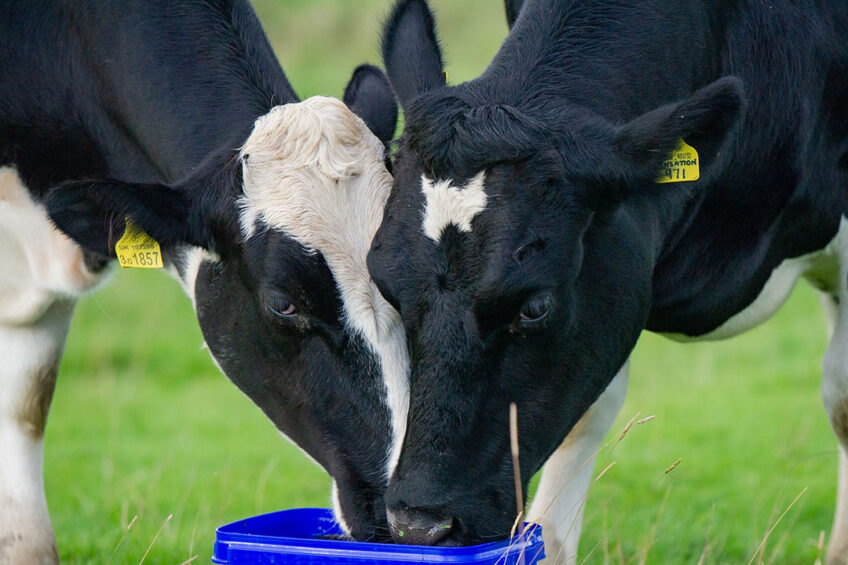Protecting the dairy herd’s future fertility

During a time when many dairy farmers are having to make rapid diet changes to reduce production, Crystalyx technical director, Dr Cliff Lister, looks at ways in which to protect your herd’s fertility.
The UK food service sector usually needs around 10 million litres of milk per week and around 50% of that has been struggling to find a home. With deflated and variable spot milk prices, the introduction of unprecedented levels of A and B quota prices, and significant disruption anticipated for some time to come, there’s no doubt the pressure to ‘take the foot off the gas’ in terms of production will be felt by many of the UK’s dairy units.

Commenting on how this is achieved, Dr Lister says, “The most obvious, and most effective action to take to lower production quickly, is to target the higher yielding cows in the herd. Feeding less compound feed is clearly an option for these animals which can then have a greater reliance on spring/summer grass. Lower yielders can milk well off grass alone, with little or no need for any concentrate input, so this action will not have any noticeable benefit. However, the high yielding animals are often the ones that are peak lactation and ready for breeding/in early pregnancy, therefore any change in nutrition has to be carefully managed as to not impact fertility. Otherwise, there can be substantial financial implications for a dairy farm business in the longer term.

“Whilst high quality grass is an excellent feed, it is not a nutritionally balanced feed source, often containing excess protein and being deficient in essential minerals and trace elements that are needed for optimum animal health and performance in the long-term. It is this long-term health and performance – getting cows back in calf and maintaining a sensible body condition at grass – which will be the key to future farm profitability.
Beware of metabolic problems
“As an industry, we are aware of the importance of transition management and, especially when we are changing our management to achieve lower yields than previous years, it is important animal health is not compromised. Poor total dry matter (and energy) intakes in early lactation encourage the mobilisation of body fat reserves as a supplementary source of energy to maintain milk output. But excessive mobilisation of these reserves can give rise to metabolic problems such as fatty liver and ketosis, both of which can have knock-on effects in terms of fertility and immune response.
“A simple and cost-effective solution to this, is to introduce a product that increases the efficiency of feed so the cow ‘gets more from what they have.’ (see Figure 1). This shows the percentage increase of digestibility when a Crystalyx feed supplement was introduced in addition to grass. Feed efficiency is achieved by stimulating the rumen bugs to digest forage. Any increase in the speed of rumen fermentation of forage is likely to increase forage intakes (due to a reduced gut fill effect) whilst improved digestive efficiency releases more energy from the forage consumed. Both scenarios increase the digestible energy intake of the cow. Even in situations where forage availability is limited, feeding Crystalyx will allow the cows to get the most nutrition out of what is on offer.
Figure 1 – Improvement in forage digestibility with Crystalyx.

Dr Lister adds, “The minerals and trace elements present in Crystalyx Cattle Booster and Crystalyx Optimum are specially designed to balance the nutrient deficiencies in grass, to keep the cow healthy and optimise her fertility. The minerals can also act as buffers to help buffer rumen acidity, whilst licking itself stimulates saliva production (saliva contains 10% sodium bicarbonate – a natural buffer) both of which help to maintain a healthy rumen pH. And a healthy rumen pH means the rumen bugs will be harder at work digesting forage which increases nutrient supply to the cow and improves the efficiency of forage use.
The study concluded that heifers with access to Cattle Booster at grass grew 35% better than control heifers, and 15% more heifers pregnant (after two synchronised AI’s) over the control group. “Put into financial terms, if the extra liveweight gain is given a value of £1.50/kg and the cost of feeding Cattle Booster was £20.02 then there was an improved margin of £35.48/heifer. Additional financial benefit was gained by an extra 15% of heifers being in-calf, with an estimated extra value of an in-calf heifer of £750 more than the value of an empty heifer sold fat. This clearly illustrates the value of ensuring dairy animals have sufficient nutrition to be productive and fertile.”
Research
Research conducted at Kansas-State University has shown that feeding Crystalyx increases the rate of cellulose digestion in the rumen, which helps maximise forage (and energy) intakes in grazing cows. “This reduces the need to mobilise body fat reserves helping to maintain better body condition and fertility.
“Mid and late-lactation cows typically have improved milk quality due to improved forage digestion. Nevertheless, Crystalyx Cattle Booster and Crystalyx Optimum can help even out irregularities and variability in forage quality, and studies at Newcastle University have shown that the poorer the quality of the forage, the greater is the improvement in forage digestibility to feeding Crystalyx, which will help to optimise both performance and fertility and future farm profitability,” Dr Lister concludes.
Table 1 – Improvements made in Daily Liveweight Gain (DLWG) and fertility.

“Improved forage efficiency and nutritional availability leads to better performance, as shown through independent research. A study carried out at Golzow in Germany looked at the improvement made in Daily Liveweight Gain (DLWG) and fertility, in terms of pregnancy rates, in dairy heifers when animals had access to Cattle Booster tubs whilst grazing (see Table 1).
For more info: crystalyx
Join 13,000+ subscribers
Subscribe to our newsletter to stay updated about all the need-to-know content in the dairy sector, two times a week.










